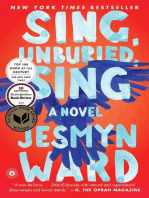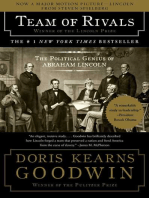Full Tilt
Full Tilt
Uploaded by
shadow121174Copyright:
Available Formats
Full Tilt
Full Tilt
Uploaded by
shadow121174Original Title
Copyright
Available Formats
Share this document
Did you find this document useful?
Is this content inappropriate?
Copyright:
Available Formats
Full Tilt
Full Tilt
Uploaded by
shadow121174Copyright:
Available Formats
FULL TILT
FULL TILT
TOURNAMENTS IN THE KINGDOM OF BRETONNIA
Nigel Stillman describes the new Tournament Game for
Bretonnian Knights in Warhammer.
50
It is, of course, against a Bretonnian Knights code of honour
to use any magic items in the tourney itself. This is a rule
which no worthy Bretonnian would even consider breaking,
for to do so would besmirch the Knights honour and bring
shame to his family. Elves and such like will of course ignore
the rule if they can get away with it. Sometimes even
Bretonnians are caught lapsing from the code of honour and
have been forced to go on a quest to redeem themselves! It is
also against the rules to take part in a tourney riding a monster
instead of a warhorse, but such an infringement of the rules is
so easily detected that even Elves wouldnt dare attempt it.
Needless to say Bretonnian tourneys are extremely popular,
noisy and ribald affairs attended by hordes of commoners
from the surrounding countryside as well as all the nobles
from miles around. The inns and taverns are filled to bursting
point and the feasting, drinking and carousing goes on for
many days. Some Knights wander the rutted tracks of
Bretonnia entering one tourney after another earning
themselves a valiant reputation. Indeed, winning a tourney is
sometimes made an errand of Knighthood and a way of
acquiring a retinue, since a successful Knight can expect to be
followed by a baggage train of prizes, armour and warhorses
and a retinue of grooms, squires and troubadours eager to
immortalise his feats in song.
When there are no wars to keep the Knights of Bretonnia
occupied, they hone their skills by means of colourful contests
of martial prowess. These contests are known as jousts,
tournaments or, in their grandest and most spectacular form,
tourneys! Tournaments are held in each of the great dukedoms
of Bretonnia several times a year. These are magnificent
events lasting for several days and attended by Knights from
all over the realm. Smaller affairs are held at the castles of
lesser nobles eager to show off their wealth and influence. On
occasions a full tourney is held in order to attract Knights
Errant as suitors for the hand of a dukes daughter a most
desirable prize indeed, and what better way for the most
worthy Knight to prove himself than by feat of arms in
competition with the finest Knights in Bretonnia.
Full Tilt is an entertaining variation of Warhammer that can be
played in a small area and within a relatively short space of
time. The only models needed are a few Bretonnian Knights,
so anyone with a copy of Warhammer will be able to take part.
The tourney is a contest between rival teams of Bretonnian
Knights who joust against each other for a grand prize and, of
course, most important of all, the honour of victory! Apart
from the hand of an eligible heiress, prizes at tourneys can be
many and varied. Sometimes the prize is a magic item, in
which case Knights often compete on behalf of their local
grail chapel to which they will donate the prize should they
win.
THE FIELDS OF BRETONNIA
The greatest tourneys are held each year in the ducal cities of
Couronne, Quenelles, Parravon, Brionne, Bordeleaux,
Gisoreux and LAnguille, but no longer in Mousillon (its
currently occupied by the Undead!). Bretonnian tourneys are
usually purely Bretonnian affairs attended by Knights from
the various dukedoms, but on rare occasions even Elven or
Empire Knights have been known to attend. Usually Elven
Knights will only take part in a tourney if the prize is a magic
item that they believe to be one of their ancient heirlooms and
which they desire to win back.
THE GRANDE TOURNEY
First Day The Pageant of Honour
The first day of the tourney is devoted to a pageant of
honour. The contenders parade around the tourney field
and ask for ladies favours. All contenders are inspected
by the heralds for possession of magic items and any
misguided individuals found to have such
dishonourable items are immediately disqualified in
disgrace and struck off the lists. The rest go through to
the contests on the second day.
Second Day The Joust
The second day is the day of the jousting contests. Pairs
of Knights joust with each other in a knockout contest.
The pairs are determined by lots. The heralds wisely ban
personal challenges from friendly tourneys so that
Knights cannot use the occasion to pursue personal
disputes. Furthermore there is the excitement of not
knowing who your opponent is until he stands opposite
you on the tourney field! Knights who are unhorsed or
beaten on lance strikes are knocked out of the tourney
altogether. The rest of the Knights in both teams may take
part in the contest on the third day.
The Third Day The Tableaux de Bataille
The third day is the day of the tableaux de bataille.
Knights from both teams alternately challenge the Black
Knight for the top prize. The order of contenders is
determined randomly for each team by lots.
F
U
L
L
T
I
L
T
from the list of entrants for each tourney. This ensures that the
teams are well matched to make for an exciting contest.
Bretonnians are not amused by watching one paladin
unhorsing a succession of hopeless contenders, a feat that does
nothing for honour or entertainment!
CREATING A JOUSTING TEAM
The tourney is fought between two or more teams of Knights
and each team is represented by a player. You and your
opponent can start playing straight away each using one of the
two example tourney rolls printed at the end of this article.
After a while youll probably want to make up your own team,
as its much more fun! To help you do this we have also
provided a blank tourney roll (are we good to you or what?).
First each player takes an equal number of Bretonnian
Knights. We suggest you try six Knights as this makes a good
sized team for a tourney. As you will see on the accompanying
tourney rolls, Tournament Knights employ the same profile as
a Knightly Hero in a Bretonnian army even though some of
the characteristics are simply not used in a joust. You can use
any Knight models in a Joust: Knights Errant, Knights of the
Realm, Questing Knights or Grail Knights. In a Joust all
Knights count the same.
Tournament Knights ride warhorses and carry lances and are
perfectly represented by the Bretonnian Knights from the
Warhammer box or, indeed, any similarly equipped
Bretonnian Knight models. The heralds rules dictate that
Knights may not have magic items or ride monstrous beasts as
such things would be an unthinkable afront to the code of
chivalry! However, Knights can have Knightly Virtues and
may also have a Ladys Favour as described later.
If you want to create your own team just photocopy the blank
record sheet at the end of this article. It has spaces for you to
fill in details of each Knights name, his Knightly Virtues and
any Ladys Favour he may have been granted. There is also
space to record wounds he might suffer during the tourney.
Invent a suitable name and shield device for each of your
Knights, choose appropriate Knightly Virtues and then roll for
a Ladys Favour. You are now ready to begin.
51
F
U
L
L
T
I
L
T
THE JOUST AND
THE TABLEAUX de BATAILLE
The tourney in Bretonnia has been refined over the centuries
into an art form with many conventions and traditions which
can be baffling to foreigners who do not understand the subtle
references involved. Tradition dictates that on the first day
there is no combat at all. Instead the Knights gather for a
parade and to solicit favours from the Bretonnian ladies in
preparation for the contests ahead. There are two contests in a
proper tourney: firstly there is the joust which takes place over
a whole day, and this is followed the next day by the tableaux
de bataille. Smaller events often feature only the joust or
attempt to cram things together to reduce costs, but a full
tourney would not be complete without the pomp of the
parade or the final dramatic conflict of the tableaux de
bataille.
Tourneys are usually fought a la plaisance which means
fighting with blunted weapons. More rarely they are fought a
loutrance which means fighting with sharp weapons.
Blunted weapons are used in most tourneys so that the best of
Bretonnian chivalry is not slaughtered leaving the realm
woefully undefended! Serious wounds are rare and the
tourney is an excuse for outrageous fun. However, if sharp
weapons are used, contenders may be mortally wounded and
such contests are therefore reserved for matters of honour or
trials by combat serious enough to warrant fighting to the
death. The rules described here are intended for tourneys
fought a la plaisance, so Knights will rarely die or suffer
serious injuries.
HERALDS RULES
AND TOURNEY ROLLS
Tournaments are not open to just any old Knight, only to those
considered eligible on grounds of renown, prowess, honour, or
in some other fashion. This is a matter for the heralds, who are
versed in all matters of chivalry, heraldry and honour. The
heralds organise the contending Knights into teams, usually
two teams, one consisting of all the Knights from the hosts
dukedom, and the other comprising Knights from the rest of
Bretonnia. The heralds are great sticklers for the rules, and not
only do they disregard those who are inexperienced or
unknown, but also those who are rather too awesome!
To keep matters in hand the heralds maintain carefully worked
out lists of eligible Knights called the tourney rolls. Only if a
Knight is named on the tourney rolls can he enter the tourney
as a contender. The herald selects the teams who will take part
52
F
U
L
L
T
I
L
T
VIRTUE TOURNEY EFFECT
Knights Virtue This is the basic virtue of Knighthood. All Knights in the tournament have
this virtue. It has no special effect in the tourney except that any Knights may
be nominated as Knights Errant. Knights Errant can have no other virtue, but
as handsome and dashing young Knights they are naturally destined to win
the heart of a fair damsel. A Knight Errant automatically receives a Ladys
Favour! Roll a D6 and treat the score as a double.
Devotion A Knight with this virtue will automatically receive a Ladys Favour entitling
him to 3 re-rolls.
Discipline The Knight practices frequently in the tiltyard and does not have to roll to see
if he is unhorsed when he is wounded.
Impetuous Knight The Knight spurs on his warhorse and so automatically strikes first. This is
regardless of which ploys are used in the joust.
Knightly Ardour During the first pass of the joust the Knight may add +1 to his Strength to
represent the vigour with which he enters into the joust.
Knightly Temper The Knight gains an extra Attack for each hit scored in the tableaux de
bataille. Work out how many hits he scores and then roll that many attacks in
addition. This virtue is only effective in the tableaux de bataille.
Noble Disdain The Knight completely disregards the first wound he suffers. He bravely
shrugs off the wound with a great show of indifference (its only a flesh
wound - Ive had worse...
Purity The Knight may never use a Swipe or Dodge ploy. His extraordinary faith
allows him to re-roll failed armour saves! The second result always stands.
Valour The Knight is so gallant and bold that he automatically gains a Ladys
Favour. Roll a D6 and treat the score as a double.
Jousting Virtue The Knight automatically hits when using a lance. This is the ultimate ability
in a joust, but remember only one Knight in any team may have this
ability during a tourney.
Each Knight is assumed to have the Knights Virtue. In
the joust the Questing Virtue and the Grail Virtue have
no effect, so any Knights who would normally have
these virtues are assumed to have the Knights Virtue
instead. The effect of the Knights Virtue in the game is
described below. In addition each Knight may also have
one other virtue chosen from the list below. Knights in
the same team must all have different virtues, the
heralds will not allow a team to include more than one
Knight with the same Knightly Virtue. If you are writing
your own tourney roll, note down which virtues your
Knights have.
KNIGHTLY VIRTUES FOR TOURNAMENTS
THE LADYS FAVOUR
On the day before the joust, the competitors parade before the
assembled crowds where it is custom for the Knights,
especially Knights Errant, to ride up to the stands of spectators
and ask the ladies for their favours. The favour is regarded as
a lucky token and no doubt this belief has come about because
some Bretonnian ladies really are secret enchantresses able to
bring good fortune to their favoured Knight. Not that these
favours are deemed in any way magical or sorcerous, which
would be frowned upon of course. They are merely considered
to be lucky in a perfectly ordinary and just way.
The Knight chooses the lady whom he regards as the most
beautiful to beg a favour from. If she is flattered by the
request, or secretly hopes that the Knight will win the contest
(perhaps because her hand in marriage is the prize) she will
attach an item of her apparel to the Knights lance. The more
intimate the garment the luckier it is believed to be and the
higher the Knight can consider himself in her estimation.
Of course, this custom always delights the multitudes of
uncouth Bretonnian peasants and townsfolk whose lewd
remarks and whistles often cause the noble ladies to blush. It
also requires a lot of bravery on the part of the most beautiful
ladies who are invariably asked to give their favour to an
embarrassing number of Knights Errant and risk catching a
chill by the end of the day. Modest Bretonnian maidens
usually attend well prepared in advance with several veils.
ROLL FOR LADYS FAVOURS
Whether the favours are really lucky no one knows, especially
since a favour will boost the courage and confidence of the
Knight to the same effect anyway! To represent this, each
favour allows the Knight to re-roll one or more dice during the
tourney. A re-roll may be used at any time in the tourney, but
each one can only be made once and is then used up. So a
Knight with several re-rolls will gradually use them up during
the tourney until he has none left. The second result always
stands and a failed re-roll cannot be re-rolled again.
How many re-rolls the Knight gains depends on the token of
the favour. If you are using the example tourney rolls there are
already Ladys favours for some of the Knights so just use
these. If you are making your own tourney roll then use the
table below. The table is based on Bretonnian folklore
regarding how lucky each garment is believed to be. By
tradition, a Knight may only beg a favour from one lady on the
first day of the tourney, and if refused, must go without. To
represent this roll two dice for each Knight taking part. If he
scores a double, he has sufficiently impressed the lady of his
choice to be granted a favour. The double score also indicates
the nature of the favour he is given.
THE JOUST
The joust is a contest between two Knights who charge at each
other three times with lances. The Knight who knocks his
opponent from his horse, or breaks more lances by striking his
opponent wins the joust.
To prepare for the joust set up the tilt in the centre of your
playing area with suitable awnings, tents, and pavilions on
either side. Each player lines up his team at one end of the tilt
and prepares for the contest.
Put the numbered shield counters in a different cup for each
team, red for one team and blue for the other. Each number
corresponds to a contender on the tourney roll. At the start of
each joust select which two opponents will fight each other by
taking a random pair of numbers from the cups.
At the end of each joust, the numbers of the unhorsed
contenders are discarded.
The number of each winning Knight is put aside to indicate
that he goes through to the next contest: the tableaux de
bataille.
Scoring in the Joust
The joust consists of three charges or passes. A Knight who
knocks his opponent out of the saddle
wins outright. Otherwise the winner is
the Knight who breaks the most lances
upon his opponent!
53
F
U
L
L
T
I
L
T
LADYS FAVOURS
2D6 score Token Re-Rolls
Double 1 Veil 1
Double 2 Wimple 2
Double 3 Kirtle 3
Double 4 Girdle 4
Double 5 Garter 5
Double 6 Tress 6
The Warhammer rules are used to determine if Knights hit,
wound and save in the usual fashion.
A lance is deemed to break if you score a successful hit and
make a successful roll to wound, even if the wound is saved.
In other words the lance is broken on striking his shield, helm
or armour and making a successful roll to wound. Striking a
crest in the same way counts the same as two broken lances.
Keep a tally of the number of lances your Knight breaks. The
Knight who breaks more lances than his opponent is the
winner.
In the event of a draw continue to make more passes until
one Knight wins by unhorsing his opponent or by
breaking his lance.
The team that
wins the
most individual jousts wins the day, but all Knights who won
their individual jousts go through to the following days event:
the tableaux de bataille.
Get Ready
A joust normally has three passes as described above. At the
start of each pass put the two Knights facing each other
approximately 12" apart at either end of the tourney field and
on opposite sides of the tilt. Each contender presents his
shielded side to his opponent.
Choose Jousting Ploys
At the start of each pass while the contenders stand ready to
charge, each player chooses one of five jousting ploy cards
which weve printed for you. When both players have chosen
their cards they are revealed simultaneously and the
contenders charge. A battle cry at this moment would be
appropriate!
Charge!
Both contenders charge simultaneously at full gallop. Move
the models so that they meet at the middle of the tilt. Since
both Knights charge together and both are only using blunted
courtesy lances the usual strength bonuses for charging with
a lance are disregarded (unless the joust is fought a
loutrance of course!). Each contender makes only one strike
(that is one attack) with his lance. Further attacks on the
Knights profile are ignored, there is only time for a single
attack during each pass.
Who strikes first
The choice of jousting ploy determines
whether or not a contender strikes first
unless a Knightly Virtue automatically
gives the Knight the first strike. The
jousting ploys are marked with a number
indicating the order of striking, the lower
54
F
U
L
L
T
I
L
T
number always strikes before the higher. If both Knights are
entitled to strike at the same time, dice to see who strikes first.
Warhorses
Warhorses do not fight because they are separated by the tilt.
Not only are the mounts prevented from biting and kicking at
each other, but the contenders gain no benefit to their armour
saving throw for their horses barding. This means that a
Knight saves on 4+.
Wounds
All Tournament Knights start with two wounds. When a
Knight suffers his first wound, roll a dice to see if he is
unhorsed. On a score of 1, 2 or 3 he is unhorsed and suffers a
second wound as he falls from the saddle at full gallop. The
Knight will therefore be seriously injured and automatically
knocked out of the tourney. If a Knight suffers a single wound
he may continue in the tourney, but any Knight that suffers a
second wound is automatically unhorsed and out of the
tournament.
AKnight who suffers a single wound, but who wins his joust,
goes through to the next days event, the tableaux de bataille.
(A good time to shout of victory!) His wound is recovered
automatically in time for the following days combat.
Next Pass
If both contenders are still in the saddle they ride around the
end of the hoarding ready to charge again in the next turn. Any
Knight who has broken his lance is handed a new one.
JOUSTING PLOYS
As the two Knights charge at each other, each must use his
skill and judgement to strike his opponent. Each Knight can
choose to aim at his opponents shield, helm, helmet crest, to
swipe his lance across his opponents front, or he might decide
to dodge his enemys lance instead. These tactics are called
ploys and each team has its own set of cards with the ploys
printed on them. Each Knight secretly chooses a jousting ploy
and once they have done so the ploys are revealed. The effect
of each ploy is described on the card (weve printed a chart
opposite for your convenience) but the most important thing
about them is that they establish which Knight strikes first.
Each ploy has a number, and the Knight with the lower
number strikes first. If both make the same ploy roll a dice to
decide which strikes first.
Of all the ploys the most difficult is to
strike the opponents crest from his
helm. This requires great skill and is
consequently worth the equivalent of
AIM FOR HELM
You aim your lance at your
opponents helm. This is
hard to hit, but even a glanc-
ing blow can wound or unhorse
your opponent so you count +1
Strength. To represent the diffi-
culty of hitting, you strike after
an opponent aiming for Shield,
but before an opponent attempt-
ing to Swipe or hit your crest.
2
two broken lances! The dodge is the simplest ploy, and not a
very honourable one, in which the Knight tries to dodge aside
rather than strike with his lance. Although this means he
cannot strike himself, he might do this during the final pass of
a joust if he is already leading the score in broken lances, thus
denying his opponent the chance to catch up.
THE TABLEAUX DE BATAILLE
The tableaux de bataille is an imaginative and spectacular
contest that is very popular with the Bretonnian ladies. The
tableaux usually has an elaborate theatrical setting inspired by
one of the many chansons, the troubadours songs which tell
of the legendary feats of arms of various paladins of
Bretonnian chivalry. This contest is held on the last day of the
tourney. The winners of the previous days jousting challenge
the Black Knight in turn, in order to win the top prize. The
Black Knight is the best Knight of the dukedom, chosen by the
Duke himself, disguised in black armour with no identifying
heraldry. He usually unhorses several challengers before
someone succeeds in beating him to win the prize!
None Shall Pass!
If the prize of the tourney is the hand of a fair damsel, the
heiress to a vacant feudal domain, a mock dungeon tower is
set up on the tourney field, surrounded by a moat, over which
is a drawbridge The lady plays the role of a damsel in
distress locked up in the tower. She leans out of the window
shouting encouragement to the Knights trying to rescue her.
Each challenger tries in turn to cross over the drawbridge and
reach the tower to rescue the damsel. Whoever succeeds wins
the prize. Unfortunately you can only cross the drawbridge by
unhorsing the Black Knight who is the guardian of the tower.
The Ring of Stones
If the prize of the tourney is an enchanted relic, the contenders
and spectators make a splendid procession over to a nearby
stone circle on the morning before the contest, which is held
in the afternoon. This will be the same place where trials by
combat are customarily held.
The prize is placed in the middle of the circle on an altar stone.
There is only one way into the circle, between two large
stones wide enough apart to admit a rider on horseback.
Guarding the circle is the Black Knight who cannot leave the
circle. Each challenger enters the circle in turn. The only way
to claim the prize is to unhorse the Black Knight.
JOUSTING PLOYS
1. Aim for Shield
You aim your lance at your opponents shield to
put maximum force behind the strike. You
automatically strike before an opponent using
any other ploy.
2. Aim for Helm
You aim your lance at your opponents helm.
This is hard to hit, but even a glancing blow can
wound or unhorse your opponent so you count
+1 Strength. To represent the difficulty of
hitting, you strike after an opponent aiming for
Shield, but before an opponent attempting to
Swipe or hit your crest.
3. Aim for Crest
You can only use this ploy once in the joust and
then only if your opponent actually has a crest
on his helm! The lance is aimed at your
opponents crest. This is difficult to hit, and will
never wound or unhorse your opponent.
Nevertheless it is a great slight upon his honour
and counts as two lance breaks! To represent the
difficulty of hitting, you strike after an opponent
aiming for Shield or Helm, but before an
opponent attempting to Swipe. You count -1 to
hit and if you score a hit the crest is knocked off
on a further roll of 4, 5 or 6.
4. Swipe
This ploy is acceptable, but not considered to be
very honourable! You swipe with the lance
across your opponents front to knock him from
his saddle. It is not difficult to hit with this ploy,
but is rather slow and not very skillful. To
represent this, you strike after an opponent
aiming for Shield, Helm or Crest, but you
always count +1 to hit.
5. Dodge
This is a defensive ploy greatly lacking in
honour. You give up your own chance to strike
in order to dodge your opponents lance. This
means that you do not strike at all, but your
opponent suffers -2 to hit (if he is entitled to an
automatic hit this is modified to 3+ to hit). If
both contenders opt for this ploy, then neither
will strike at all.
SWIPE
This ploy is acceptable, but
not considered to be very
honourable! You swipe
with the lance across your oppo-
nents front to knock him from
his saddle. It is not difficult to
hit with this ploy, but is rather
slow and not very skilful. To
represent this, you strike after an
opponent aiming for Shield,
Helm or Crest, but you always
count +1 to hit.
4
55
F
U
L
L
T
I
L
T
TOURNEY PRIZES
It will no doubt occur to many players with Bretonnian armies
and a passion for all things Bretonnian to make tourneys part
of a campaign set in Bretonnia. As always, it is up to the
players involved to agree amongst themselves how to do this
and how they might adapt the basic rules to take account of the
odd visiting team of Elven or Empire Knights. Indeed the
campaign could simply take the form of the grand circuit of
tourneys in Bretonnia, since each dukedom holds its tourney
in a different month to the others, making it possible for
Knights to go from one to another amassing renown and prizes
as indeed many do! It would of course be great if the tourney
prizes were something which you could use in future
Warhammer battles, so here are a few suggestions:
Recovery of Characters
Firstly it must be assumed that all Knights eventually recover
from wounds received during the tourney unless the tourney
was fought a loutrance, using sharp weapons!
For the traditional tourney fought
a la plaisance, with blunted
weapons, roll a dice for each
unhorsed character. On a
score of 1, his wounds
were sufficiently severe
for him
CHALLENGING
THE BLACK KNIGHT
Each contender challenges the Black Knight in turn. The order
in which contenders challenge him is determined randomly as
for the jousting.
Both the challenger and the Black Knight charge each other
with lances, counting only one attack each. The bonus for
charging with lance is disregarded as in the joust since the
tableaux is also fought a la plaisance. Jousting ploys are not
used, since both Knights are honour bound to aim for their
opponents shield. Both contenders roll off to see who strikes
first in the initial round. If one or other is wounded make a
further roll to see whether he is unhorsed and therefore
knocked out of the contest. The prowess of the Black Knight
is such that he can only be unhorsed on a roll of 1!
Subsequent rounds of the combat are fought with blunted
maces or morning stars which make for a noisy, robust and
entertaining spectacle in which both Knights end up with their
shields well and truly dented! The Knights now make their full
number of attacks, and use Initiative to determine who goes
first. The contest continues until one or other of the Knights is
unhorsed. If a challenger is unhorsed, the next challenger rides
out. As in the joust, warhorse attacks and warhorse barding are
disregarded.
Wounds taken by the Black Knight are cumulative and when
he has suffered his full wounds he is automatically unhorsed
which means that his current opponent wins. Your chances of
beating the Black Knight are therefore better if your Knights
are not among the first to challenge him!
THE BLACK KNIGHT
The Black Knight wears black armour, a black surcoat and
carries a black shield bearing no blazon by which he can be
recognised. No one knows the true identity of the Knight who
plays the role of the Black Knight. All that you can be sure of
is that he will be a Knight of great renown and martial
prowess! It could be the Duke himself, the best Knight in the
Dukes retinue or a hermit Grail Knight from a remote grail
chapel somewhere in the dukedom. According to legend
sometimes the King of Bretonnia himself has played the role
of the Black Knight in the tournament at Couronne!
M WS BS S T W I A Ld
Black Knight 4 6 6 4 4 3 6 3 9
Warhorse 8 3 0 3 3 1 3 1 5
EQUIPMENT: The Black Knight wears heavy armour,
carries a shield and rides a barded Bretonnian warhorse. He is
armed with a mace or morning star and lance.
SAVE: 4+ (disregarding barded mount).
KNIGHTLY VIRTUES
The Black Knight has the Knights Virtue as do all Knights,
although this has no effect in the tournament. He also has the
Virtue of Knightly Temper and so gains an extra attack for
each initial hit scored. Work out how many hits he scores and
then roll that many attacks in addition.
56
F
U
L
L
T
I
L
T
The Black Knight
in Bretonnian Folklore
The Black Knight is an old and well known figure of
Bretonnian folklore and legend. In his aspect as
something to be dreaded, he undoubtedly embodies
the age old fear of the Chaos Knight, the Dark Elf
rider or the Undead horseman who have plagued
Bretonnia since time immemorial. Thus he
represents the archetypal adversary of a bold
Bretonnian Knight. In his less ominous aspect, he
represents the anonymous Knight. Such a Knight
may wish to disguise his identity under black,
shabby robes, lacking any heraldic device by which
he may be recognised. Some Questing Knights do
indeed adopt such a garb. There is always
speculation as to why a Knight should do this,
maybe it is because he must redeem his honour, or
has he forsaken the true faith like the villain
Maldred?
Whatever the reason, is it not the duty of any
virtuous Knight to challenge such a character and
force him to yield, so that his identity may be made
known?
to miss the next battle or tourney recovering in the delicate
care of the local Grail Damsels. All other scores indicate
superficial wounds. If the tourney is fought a loutrance
simply reduce the chance that the Knight recovers. Any
Knight who was lucky enough to have a Ladys favour may
re-roll his recovery score if he has any re-rolls left!
Jousting Prizes
Each Knight who successfully gets through the jousting of the
second day of the tourney wins great renown and gains
experience. To represent this you might consider raising any
one of his profile characteristics by +1 as long as no
characteristic is ever raised more than once. This is done after
all jousting is over, but before the tableaux de bataille on the
third day. A character who enhances his profile in this way
would be able to use his new profile in subsequent tourneys or
in battle. He might also add to his heraldry a special blazon to
show that he is a victor in the joust, a striped lance perhaps or
a laurel wreath around his helm.
The Prize of the
Tableaux de Bataille
This is the ultimate prize of the tourney. If the tableaux de
bataille was the tableaux of the dungeon tower then the prize
would be the hand of the damsel herself. There is more to this
prize than a fair Bretonnian damsel,
perhaps a castle and feudal
domain complete with a
modest retinue of: 1
Mounted Squire, 1
Foot Squire, 1 Man-at-
arms and 1 Archer. The
Knight would then
automatically become a Knight of the Realm if he is not one
already. If the Knight is fielded in your army you might
perhaps add his retainers to your army at no extra points cost
although you would still pay the points for the Knight himself.
If the tableaux de bataille was the tableaux of the stone circle,
then the prize would be a magic weapon up to a value of 50
points, which was recently discovered somewhere in the
dukedom, or brought back from an errantry war in some far
flung place. Such a weapon must be chosen randomly from
the Magic Weapon cards by cutting the deck. It can then be
used by the character in battle at no extra points cost, but still
counts as part of his usual quota of magic items.
Wounded Knights
On the whole, it is rare for contenders to be mortally wounded
in a tourney. Knights who are dragged off the field as
casualties are usually just stunned, have cuts and bruises or the
occasional broken bone. This is mainly because of their
effective armour and padded jerkins worn beneath and also
because, unlike in battle or trial by combat, a Knight will not
deliver the coup de grace to an opponent in a friendly tourney.
Wounded Knights who are not unhorsed have their wounds
bandaged up after the days events and can continue to take
part in further tourneys or battles with
their full Wounds value.
57
F
U
L
L
T
I
L
T
BLUE TEAM TOURNEY ROLL
KNIGHT 1 M WS BS S T W I A Ld Save
Francois Theriault 4 5 5 4 4 2 5 3 8 4+
Francois has the Knights Virtue, He has a Ladys favour,
the Girdle.
KNIGHT 2 M WS BS S T W I A Ld Save
Etoile Le Loup 4 5 5 4 4 2 5 3 8 4+
Etoile has the Knights Virtue, He has a Ladys favour,
the Kirtle.
KNIGHT 6 M WS BS S T W I A Ld Save
Villars de la Verite 4 5 5 4 4 2 5 3 8 4+
Villars has the Knights Virtue and the Virtue of Discipline,
KNIGHT 5 M WS BS S T W I A Ld Save
Gaston dAnjou 4 5 5 4 4 2 5 3 8 4+
Gaston has the Knights Virtue and the Virtue of
Knightly Temper
KNIGHT 4 M WS BS S T W I A Ld Save
Alphonse de Bordeleaux 4 5 5 4 4 2 5 3 8 4+
Alphonse has the Knights Virtue and the Virtue of Purity,
KNIGHT 3 M WS BS S T W I A Ld Save
Hue de Brionne 4 5 5 4 4 2 5 3 8 4+
Hue has the Knights Virtue and the Jousting Virtue,
Here are the two example tourney rolls so that you can start playing Full Tilt straight away
RED TEAM TOURNEY ROLL
KNIGHT 1 M WS BS S T W I A Ld Save
Jehan Le Concourant 4 5 5 4 4 2 5 3 8 4+
Jehan has the Knights Virtue, He has a Ladys favour,
the Veil.
KNIGHT 2 M WS BS S T W I A Ld Save
Artois Trintignat 4 5 5 4 4 2 5 3 8 4+
Artois has the Knights Virtue, He has a Ladys favour,
the Garter.
KNIGHT 3 M WS BS S T W I A Ld Save
Jaques de Gisoreux 4 5 5 4 4 2 5 3 8 4+
Jaques has the Knights Virtue and the Virtue of Devotion,
KNIGHT 4 M WS BS S T W I A Ld Save
Louis de Parravon 4 5 5 4 4 2 5 3 8 4+
Louis has the Knights Virtue and the Virtue of
Knightly Ardour,
KNIGHT 5 M WS BS S T W I A Ld Save
Marcel de Charlois 4 5 5 4 4 2 5 3 8 4+
Marcel has the Knights Virtue and the Virtue of
Noble Disdain,
KNIGHT 6 M WS BS S T W I A Ld Save
Leon dArden 4 5 5 4 4 2 5 3 8 4+
Leon has the Knights Virtue and the Jousting Virtue,
BRETONNIAN TOURNEY ROLL
KNIGHT 1 M WS BS S T W I A Ld Save
4 5 5 4 4 2 5 3 8 4+
KNIGHTLY VIRTUES & FAVOURS
and here is a blank copy of the tourney roll for you to make up your own jousting teams. Just
write your Knights names in the spaces provided and draw their heraldry on the shields.
KNIGHT 2 M WS BS S T W I A Ld Save
4 5 5 4 4 2 5 3 8 4+
KNIGHTLY VIRTUES & FAVOURS
KNIGHT 3 M WS BS S T W I A Ld Save
4 5 5 4 4 2 5 3 8 4+
KNIGHTLY VIRTUES & FAVOURS
KNIGHT 4 M WS BS S T W I A Ld Save
4 5 5 4 4 2 5 3 8 4+
KNIGHTLY VIRTUES & FAVOURS
KNIGHT 5 M WS BS S T W I A Ld Save
4 5 5 4 4 2 5 3 8 4+
KNIGHTLY VIRTUES & FAVOURS
KNIGHT 6 M WS BS S T W I A Ld Save
4 5 5 4 4 2 5 3 8 4+
KNIGHTLY VIRTUES & FAVOURS
Copyright Games Workshop Ltd. 1997.
All rights reserved. Permission to photocopy this sheet for personal use only.
61
F
U
L
L
T
I
L
T
You might also like
- The Subtle Art of Not Giving a F*ck: A Counterintuitive Approach to Living a Good LifeFrom EverandThe Subtle Art of Not Giving a F*ck: A Counterintuitive Approach to Living a Good LifeRating: 4 out of 5 stars4/5 (5891)
- The Gifts of Imperfection: Let Go of Who You Think You're Supposed to Be and Embrace Who You AreFrom EverandThe Gifts of Imperfection: Let Go of Who You Think You're Supposed to Be and Embrace Who You AreRating: 4 out of 5 stars4/5 (1103)
- Never Split the Difference: Negotiating As If Your Life Depended On ItFrom EverandNever Split the Difference: Negotiating As If Your Life Depended On ItRating: 4.5 out of 5 stars4.5/5 (870)
- Grit: The Power of Passion and PerseveranceFrom EverandGrit: The Power of Passion and PerseveranceRating: 4 out of 5 stars4/5 (597)
- Hidden Figures: The American Dream and the Untold Story of the Black Women Mathematicians Who Helped Win the Space RaceFrom EverandHidden Figures: The American Dream and the Untold Story of the Black Women Mathematicians Who Helped Win the Space RaceRating: 4 out of 5 stars4/5 (912)
- Shoe Dog: A Memoir by the Creator of NikeFrom EverandShoe Dog: A Memoir by the Creator of NikeRating: 4.5 out of 5 stars4.5/5 (543)
- The Hard Thing About Hard Things: Building a Business When There Are No Easy AnswersFrom EverandThe Hard Thing About Hard Things: Building a Business When There Are No Easy AnswersRating: 4.5 out of 5 stars4.5/5 (352)
- Elon Musk: Tesla, SpaceX, and the Quest for a Fantastic FutureFrom EverandElon Musk: Tesla, SpaceX, and the Quest for a Fantastic FutureRating: 4.5 out of 5 stars4.5/5 (474)
- Her Body and Other Parties: StoriesFrom EverandHer Body and Other Parties: StoriesRating: 4 out of 5 stars4/5 (830)
- The Sympathizer: A Novel (Pulitzer Prize for Fiction)From EverandThe Sympathizer: A Novel (Pulitzer Prize for Fiction)Rating: 4.5 out of 5 stars4.5/5 (122)
- The Little Book of Hygge: Danish Secrets to Happy LivingFrom EverandThe Little Book of Hygge: Danish Secrets to Happy LivingRating: 3.5 out of 5 stars3.5/5 (414)
- The Emperor of All Maladies: A Biography of CancerFrom EverandThe Emperor of All Maladies: A Biography of CancerRating: 4.5 out of 5 stars4.5/5 (272)
- The Yellow House: A Memoir (2019 National Book Award Winner)From EverandThe Yellow House: A Memoir (2019 National Book Award Winner)Rating: 4 out of 5 stars4/5 (99)
- The World Is Flat 3.0: A Brief History of the Twenty-first CenturyFrom EverandThe World Is Flat 3.0: A Brief History of the Twenty-first CenturyRating: 3.5 out of 5 stars3.5/5 (2270)
- Devil in the Grove: Thurgood Marshall, the Groveland Boys, and the Dawn of a New AmericaFrom EverandDevil in the Grove: Thurgood Marshall, the Groveland Boys, and the Dawn of a New AmericaRating: 4.5 out of 5 stars4.5/5 (269)
- Team of Rivals: The Political Genius of Abraham LincolnFrom EverandTeam of Rivals: The Political Genius of Abraham LincolnRating: 4.5 out of 5 stars4.5/5 (235)
- A Heartbreaking Work Of Staggering Genius: A Memoir Based on a True StoryFrom EverandA Heartbreaking Work Of Staggering Genius: A Memoir Based on a True StoryRating: 3.5 out of 5 stars3.5/5 (232)
- InsylumDocument31 pagesInsylumIago MendonçaNo ratings yet
- Tactical Combatives Course (Level II) HandbookDocument209 pagesTactical Combatives Course (Level II) Handbookshadow121174100% (2)
- On Fire: The (Burning) Case for a Green New DealFrom EverandOn Fire: The (Burning) Case for a Green New DealRating: 4 out of 5 stars4/5 (74)
- Human Occupied LandfillDocument141 pagesHuman Occupied Landfillmarcosmatch9100% (2)
- Killing On Carnival RowDocument117 pagesKilling On Carnival Rowshadow121174No ratings yet
- The Unwinding: An Inner History of the New AmericaFrom EverandThe Unwinding: An Inner History of the New AmericaRating: 4 out of 5 stars4/5 (45)
- 21 Guns (3965009)Document2 pages21 Guns (3965009)shadow121174No ratings yet
- Cards Hunters Apr2016 PagesDocument2 pagesCards Hunters Apr2016 Pagesshadow121174No ratings yet
- En FAITH The Sci-Fi RPG LoreDocument56 pagesEn FAITH The Sci-Fi RPG Loreshadow12117467% (6)
- Nights of The CrusadesDocument114 pagesNights of The Crusadesshadow121174100% (1)
- AFMBE - ZM Screen ErrataDocument1 pageAFMBE - ZM Screen Erratashadow121174No ratings yet
- Cases On Non-Delegability of Taxing PowerDocument5 pagesCases On Non-Delegability of Taxing PowerCharmaine Ganancial SorianoNo ratings yet
- Argumentative EssayDocument5 pagesArgumentative Essayapi-461034253No ratings yet
- Detection & Disp - of Forged NotesDocument35 pagesDetection & Disp - of Forged Notesjashim_urNo ratings yet
- 13002Document3 pages13002satishNo ratings yet
- A FR Cuf T GuidebookDocument28 pagesA FR Cuf T GuidebookSofía Arango HenaoNo ratings yet
- Character Sketch of Mrs AlvingDocument1 pageCharacter Sketch of Mrs AlvingSauhardya RitNo ratings yet
- Blood NinjaDocument11 pagesBlood NinjaKingCold999No ratings yet
- Fill in The Story With The Missing WordsDocument3 pagesFill in The Story With The Missing WordsCarolina Serrano CabezaNo ratings yet
- Valente V The QueenDocument2 pagesValente V The QueenJennifer AshrafNo ratings yet
- What Is Dispute ResolutionDocument10 pagesWhat Is Dispute ResolutionNorHazren Izatie MohdNo ratings yet
- The Paschal MysteryDocument2 pagesThe Paschal MysteryJan Paul Salud LugtuNo ratings yet
- Sherlock Holmes and The Blue Diamond - ExerciDocument8 pagesSherlock Holmes and The Blue Diamond - ExerciKismado07No ratings yet
- (The Inscription of Zuhayr, The Oldest Islamic Inscription - (24 AH - AD 644-645 - )Document2 pages(The Inscription of Zuhayr, The Oldest Islamic Inscription - (24 AH - AD 644-645 - )ktotaki50% (2)
- People V GaliciaDocument3 pagesPeople V GaliciaStephanie TumulakNo ratings yet
- Villareal Vs People of The PhilippinesDocument6 pagesVillareal Vs People of The PhilippinesmyschNo ratings yet
- Hamlet As A Revenge Tragedy 3Document3 pagesHamlet As A Revenge Tragedy 3xbabaxNo ratings yet
- 198935Document11 pages198935The Supreme Court Public Information OfficeNo ratings yet
- MADE YOU LOOK - Meghan TrainorDocument2 pagesMADE YOU LOOK - Meghan TrainorAnthenadona OlymusNo ratings yet
- De La Paz V SenateDocument4 pagesDe La Paz V SenateTheodore BallesterosNo ratings yet
- 《第十二夜》Document16 pages《第十二夜》2937180349No ratings yet
- Sample ProgramDocument10 pagesSample ProgramJeffrey MaloneNo ratings yet
- Sample Government Official Letter FormatDocument3 pagesSample Government Official Letter FormatDarrell33% (3)
- Fortune Care v. AmorinDocument2 pagesFortune Care v. AmorinKaren Joy MasapolNo ratings yet
- List of Bivalve Mollusc Processing Establishments (10. 2019)Document3 pagesList of Bivalve Mollusc Processing Establishments (10. 2019)Nguyễn Vũ HoàngNo ratings yet
- Activity 1 - Agreement Between Subject and VerbDocument1 pageActivity 1 - Agreement Between Subject and VerbЖеня ДзяткоNo ratings yet
- The Federal LegislatureDocument14 pagesThe Federal LegislatureChina WeiNo ratings yet
- 025 DIGESTED El Pueblo de Filipinas Vs Pablo San Juan y Monterosa - No. L-46896Document4 pages025 DIGESTED El Pueblo de Filipinas Vs Pablo San Juan y Monterosa - No. L-46896Paul ToguayNo ratings yet
- Gusa - Eshi Me LLCDocument2 pagesGusa - Eshi Me LLCIDL_ReporterosNo ratings yet
- 7 Appendix 2Document21 pages7 Appendix 2데이브자바이No ratings yet
- George Mckee and Araceli Koh Mckee, PetitionersDocument14 pagesGeorge Mckee and Araceli Koh Mckee, PetitionersGay C. Caragan-MakaniNo ratings yet















































































